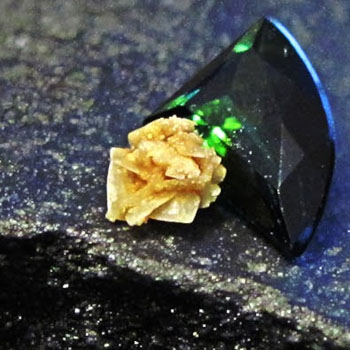Hydroxycitrate Potentially More Effective Than Citrate for Kidney Stones
By LabMedica International staff writers
Posted on 18 Aug 2016
The chemical hydroxycitrate (HCA) was shown in a recent study to be more effective for treating calcium oxalate kidney stones than the commonly used compound potassium citrate.Posted on 18 Aug 2016
Calcium oxalate monohydrate is the principal component of human kidney stones and citrate (CA) is an often-used therapy, but hydroxycitrate (HCA) is not. In a study published in the August 8, 2016, online edition of the journal Nature, investigators at the University of Houston (TX, USA) used techniques of bulk crystallization, in situ atomic force microscopy, and density functional theory to compare the capacity of CA and HCA to prevent or even reverse the growth of calcium oxalate crystals.

Image: A kidney stone (yellow) composed of calcium oxalate showing sharp edges (Photo courtesy of Wikimedia Commons).
The investigators reported finding a mechanism that differed from classical theory in that inhibitor adsorption on crystal surfaces induced dissolution of the crystal under specific conditions rather than merely reducing the rate of crystal growth. This phenomenon occurred even in supersaturated solutions where the inhibitor concentration was three orders of magnitude less than that of the solute.
Decrease in crystal size was explained by a hypothesis, generated from atomic force microscopy observations, that inhibitor–crystal interactions imparted localized strain to the crystal lattice and that oxalate and calcium ions were released into solution to alleviate this strain.
For HCA to function as a kidney stone treatment, it must be excreted in urine. The investigators reported that HCA ingested by non-stone-forming humans at an often-recommended dose led to substantial urinary excretion. In vitro assays using human urine revealed that HCA was as effective an inhibitor of nucleation of calcium oxalate monohydrate nucleation as was CA. These findings supported further exploration of the clinical potential of hydroxycitrate as an alternative treatment to citrate for kidney stones.
Senior author Dr. Jeffrey D. Rimer, associate professor of chemical engineering at the University of Houston, said that, "While this research established the groundwork to design an effective drug, questions remain. Long-term safety, dosage, and additional human trials are needed. But our initial findings are very promising. If it works in vivo, similar to our trials in the laboratory, HCA has the potential to reduce the incidence rate of people with chronic kidney stone disease."
Related Links:
University of Houston




 assay.jpg)








